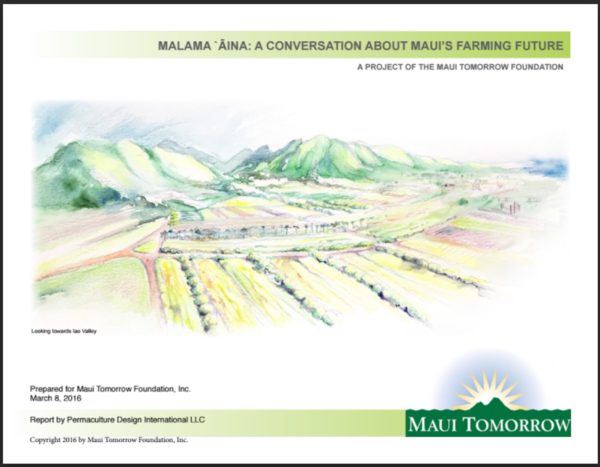Another period in the history of Hawai`i appears to be coming to a close with the announcement by Alexander & Baldwin (A&B) that they are closing their sugar operations on Maui under their subsidiary, HC&S.
Many people look at the 36,000 acres that HC&S currently farms on Maui and wonder what the future will look like in the years to come. Will we be able to feed our growing island community and stop importing over 90% of our foodstuffs? Will those green fields of cane be replaced by a barren dust bowl, unable to adequately sustain and grow new crops? Or worse yet, will it be paved over and developed, thereby killing our island way of living and ushering in a period of urbanized, metropolitan living?
We have the chance to create something sustainable, profitable AND healthy for our ‘āina (land), our ‘ohana (families) and our community.
Working together with Permaculture Design International LLC, Maui Tomorrow has come up with ideas and possible solutions that would not only put Maui on the map as a leader in this systemic and holistic approach to agriculture, but could also create MORE jobs than our community is losing. Join us as we begin a community conversation about the many opportunities for rejuvenation of the agricultural sector of our economy in ways that would be Pono for our environment and our people.
To clarify, this report is a point to begin conversation regarding farming on those vast acres and is not associated in any way with a current movement known as “The Community Organic Farmland Initiative”. Maui Tomorrow and this project seek to broaden the range of options with regards to possible uses of the land.
Click on the image above or view the entire report here: Future of Maui.org


Ev Senter
This is a huge opportunity for Maui. I see in the “Malama Aina” of Maui Tomorrow the potential answer to many of our most pressing problems: water, locally grown food, immediate employment for the soon to be laid off agricultural and other workers, healthier and more affordable diet and environment (cleaner air and less smoke/dust) for all Maui residents, beautiful care of our beautiful land and aloha for all on the island. We need to gather our government, political and economic leaders and all the folks who understand and care about farming and all matters ecological, not to mention those who understand funding. Until then, here is my take on this (I have practiced organic farming, and have some economics background):
a. We have the need, desire, interest and possibly the funding to achieve this grand vision for Maui.
b. The way to start is to take advantage of what we already have and improve it, just as is presented in this study.
c. A possible way to pay for it is to apply the money that is going to be needed and is legally required to be paid for unemployment compensation for the laid off, and get double our money’s worth out of that money by “not quite” employing the unemployed, by allowing them to volunteer their time as students of the complex issues of land and crop selection and management, soil improvement, water retention — all of this without additional pay but also without tuition or education charge during the non-income producing year(s) of land restoration in the “Malama Aina” plan, but given preference on the list of future restored plots of the said land for growing of crops that will be sold to the public through coops voluntarily established to sell the healthiest possible produce and animal products (or young animals themselves) to growers or to those who want pets and have the space already.
d. I think we should add all the benefits claimed for this proposal to the 100% ecological energy plan for Maui that is already in existence. The “Malama Aina” will provide some input into that plan, but why not add water conservation, stream/river replenishment, irrigation for all farmers within reach of stream water, less pollution of our streams and nearby ocean waters, and all remaining benefits that can potentially result from this plan, and declare them as part of our “Maui Plan for Sustainabile Healthy Living for all residents.”
e. Imagine offering diverse “how to” training after the plan has shown its capabilities for anyone who would want to come and learn (possibly with a fee for their stay — optional room and healthy board). Adding UH to the education plan would be beneficial to UH as well as Maui residents and would also offer a bonus for those in the tourist industry interested in attracting “eco-tourists.” “The potential for creating a world-class educational curriculum on this site should not be understated” says the study. “As a venue, Hawai`i and Maui are in high demand, and this project expands on the ever-growing sector of agricultural and educational tourism. Recruiting the world’s leading regenerative designers as instructors and hands-on trainers can put Maui on the map for excellence in regenerative agricultural education.”
f. Maui could also become a world resource for breeding and sales of organic open-pollinated (non-GMO) heirloom seeds.
Congratulations on getting this report into our hands. Let’s now put it into practical use. Aloha.
For the full article, go to: http://www.futureofmaui.org/project-frame-viewer/
Madeleine Migenes
I cannot open this document on my computer. Is there another way I can read it?
Maui Tomorrow
We apologize that you were unable to access the report. Please try the link again or click on the image above it to access a PDF of the report which is 52 pages long.
Steve
cannot view report…google won’t allow access
Maui Tomorrow
Aloha! Please try the link again or click on the image above it in the post to be taken to a PDF of the report.